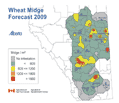| |
2009 Alberta Wheat Midge Forecast | |
| |
|
|
| |
|
|
| |
The Alberta wheat midge forecast for 2009 shows a decrease in the intensity of wheat midge in Alberta. Following the extreme forecast for 2008 risk levels are much lower going into the new crop year. This reduction in midge risk has also occurred in Saskatchewan. This forecast agrees with the Canadian Grain Commission harvest unload survey that looks at samples with midge damage noted in the grading. There exists enough midge over widely separated areas that individual fields could still be at risk. Producers throughout the midge area will need to monitor their fields closely in 2009. High levels of midge were found in irrigated wheat in the Newell County.
| 
Click for a larger map |
 |  |
The 2009 fall survey sampling was increased to include almost all the counties that dark brown or black soils in central and southern Alberta. In addition irrigated wheat was sampled throughout southern Alberta. In total 212 samples were taken in 43 different counties. The larval cocoons are washed out of the soil samples and counted, and then dissected to determine if they are parasitized.
The forecast is not intended to take the place of individual field monitoring. Even though the forecast for Alberta shows elevated risk of midge damage over a wide range, populations in individual fields can be highly variable. Producers should plan on monitoring their fields when the midge adults are flying and the wheat is in the susceptible stage. In all areas where wheat midge is present growers are urged to monitor wheat fields during the susceptible period (when the wheat head becomes visible as the boot splits until mid-flowering (anthesis)). Regular field scouting on multiple nights in succession is important in understanding the population in a particular field. Temperature and wind play critical roles in egg-laying of the adult female midge.
Diagnostic guide
Life cycle information
FAQ
Canadian Grain Commission harvest unload survey
Economic thresholds for orange blossom wheat midge
Parasitism of midge larvae by small wasps has been important in keeping wheat midge populations below the economic threshold. These beneficial wasps tend to have better success under warm, dry conditions. Parasite populations will ultimately rise with increases in the midge populations. The midge density on the forecast map is adjusted for parasitized larvae. Natural enemies have traditionally been very important in managing population levels in Alberta.
It is important to note that once midge has established in an area it is unlikely to ever completely disappear. Low lying and moist areas in a field provide a refuge, enabling the population to survive even when conditions are not favorable in the rest of the field. These low level populations, however, help sustain a population of natural enemies.
The distribution of wheat midge as illustrated in the 2009 Forecast Map is based on cocoons present in soil samples collected in a 2008 fall survey. Although a number of factors influence over-wintering survival of the midge, the survey and map provide a general picture of existing densities and the potential for infestation in 2008. Climatic conditions, mainly temperature and moisture, will ultimately determine the extent and timing of midge emergence during the growing season.
Updates of current conditions and wheat midge emergence will be available through the Ag-Info Centre (310 FARM) during the 2009 growing season.
The wheat midge survey was conducted by Alberta Agriculture and Rural Development with assistance from Lakeland Applied Research Association, Battle River Research Group and the County of Wainwright. Soil samples were processed by Alberta Agriculture and Rural Development. The survey was funded by Alberta Agriculture and Rural Development with support from Dow AgriScience.
Follow this link for a page size printable map. |
|
| |
|
|
| |
For more information about the content of this document, contact Scott Meers.
This document is maintained by Shelley Barkley.
This information published to the web on January 26, 2009.
Last Reviewed/Revised on February 22, 2011.
|
|